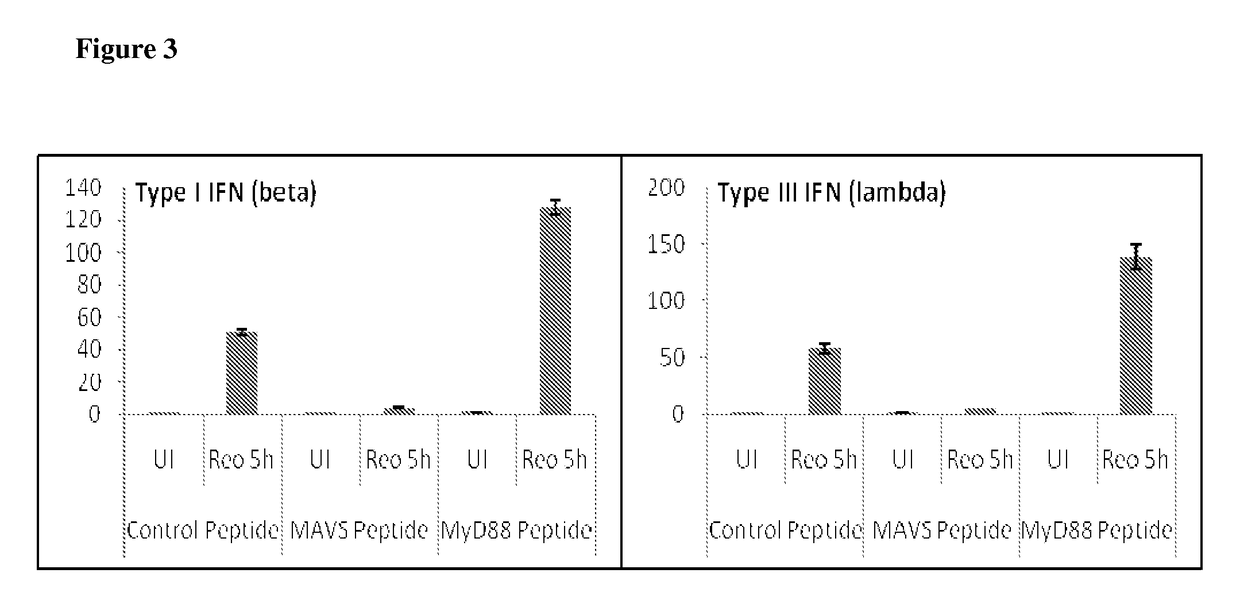Modulators of antiviral signaling pathways and therapeutic uses thereof
a technology of antiviral signaling pathway and modulator, which is applied in the direction of antibody medical ingredients, peptide sources, metabolic disorders, etc., can solve the problems of few rlr specific inhibitors and activators available, and achieve the effect of facilitating the delivery of rlr inhibitors
- Summary
- Abstract
- Description
- Claims
- Application Information
AI Technical Summary
Benefits of technology
Problems solved by technology
Method used
Image
Examples
example 1
Design of a Peptide-Based Inhibitor of RLR Signaling
[0194]The study of the innate immune responses to viral infection has been greatly advanced by the use of reverse genetic approaches to dissect virus-induced signaling pathways (Akira et al., Cell 124:783-801 (2006)). In mammalian cells, these approaches have led to the identification of the two primary antiviral response systems known as the Toll-like Receptor (TLR) family and the RIG-I like Receptor (RLR) family. Among these, RLRs are unique in that they function in all mammalian cells, and thus, provide the only known comprehensive immune-surveillance network operating to detect infections (Beutler et al., Annu. Rev. Immunol. 24:353-389 (2006)).
[0195]There are currently no known inhibitors that specifically target the RLR-mediated antiviral signaling pathways. In considering how to create a RLR-specific inhibitor, focus was directed to the earliest-acting regulators of signal transduction because it is at the receptor proximal l...
example 2
MAVS Peptide Inhibitor Specifically Blocks RLR-Induced Antiviral Signaling in Human Cells
[0198]To determine if the MAVS peptide can block RLR signaling in human cells, experiments were performed in the human intestinal epithelial cell (IEC) line T84 comparing the peptide to a previously characterized antennapedia-peptide that targets the TLR adaptor MyD88. These cells were chosen because it is well-known that many viruses penetrate the intestinal epithelium and it has been shown that they respond naturally to both TLR and RLR ligands (FIG. 2 and data not shown). Polarized T84 cells were pretreated for 1 hour with each peptide and then treated for 5 hours with synthetic viral RNA PolyIC, which activates signaling by both RLRs. Quantitative RT-PCR analysis showed that PolyIC activated the expression of the Type I IFN (IFNβ) and Type III IFN IL-29, also known as IFN lambda (FIG. 2). Interestingly, the MAVS peptide completely abolished the expression of both IFNs in response to PolyIC. ...
PUM
| Property | Measurement | Unit |
|---|---|---|
| concentration | aaaaa | aaaaa |
| body weight | aaaaa | aaaaa |
| covalent | aaaaa | aaaaa |
Abstract
Description
Claims
Application Information
 Login to View More
Login to View More - R&D
- Intellectual Property
- Life Sciences
- Materials
- Tech Scout
- Unparalleled Data Quality
- Higher Quality Content
- 60% Fewer Hallucinations
Browse by: Latest US Patents, China's latest patents, Technical Efficacy Thesaurus, Application Domain, Technology Topic, Popular Technical Reports.
© 2025 PatSnap. All rights reserved.Legal|Privacy policy|Modern Slavery Act Transparency Statement|Sitemap|About US| Contact US: help@patsnap.com



